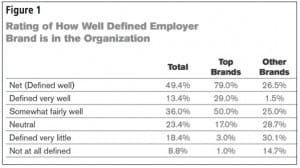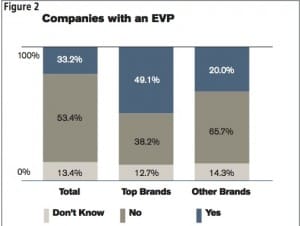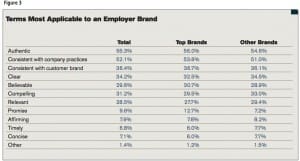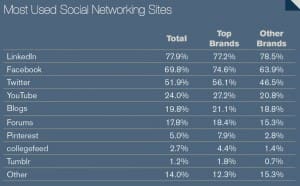 Up your talent game with these branding strategies.
Up your talent game with these branding strategies.
By The Editors
Ten years ago, few human resource executives gave much consideration to the employer brand. Today, as markets become more sophisticated and high quality talent is more difficult to find, HR leaders now realize they can’t simply rely on a strong consumer brand to recruit skilled individuals. Organizations must seek out the human capital that will set their companies apart, speak specifically to the career desires of these target candidates, and then effectively tell the story of what it’s like to work for their organizations.
Forward-thinking organizations understand the need to leverage all possible means to attract and retain top talent. Services like Glassdoor have illuminated the power of the employer brand and its attractiveness to potential employees. Nearly eight in 10 employers cite employer brand as important or very important. It is pivotal for organizations to build a business strategy around the employer brand to land superior candidates. According to the U.S. Department of Labor, the average cost of a bad hiring decision can equal 30 percent of that individual’s first year potential earnings. Most organizations spend less than 10 hours with a job candidate before extending an offer of employment. Yet, they will end up spending more waking hours with this person at work than they do with their own families at home.
“Ensuring that you have a clear reason for potential employees to come and work for you is key,” says Kimberley Hubble, Hudson RPO’s global RPO leader. “There is a clear understanding in business today that exceptional talent will always looks for organizations that are in-line with their values as well as the career progression that they want for their future. If a business is unable to articulate and promote the benefits of working for them, then its ability to attract these exceptional employees is limited.”
An employer brand can be the first opportunity to allow potential applicants who don’t fit your organization’s culture to opt out. With a clearly identified employer brand, organizations ensure that candidates have a solid cultural fit, encouraging greater productivity, increased levels of engagement, higher rates of retention, and superior bottom-line results.
“A great employer brand is not only limited to attracting great talent but also retaining them and reinforcing the value proposition and why this is a great place to work,” notes Hubble. “Clients who are looking to engage with these companies want to know that the people they are engaging with have the best talent and can keep them, therefore it also effects an organization’s ability to attract and retain great clients.”
A new research report from HRO Today and Hudson RPO, How to Launch a Successful Employer Brand: Building on the Practices of Top Employer Brands, offers organizations strategic advice on instituting and leveraging employer brand for a competitive edge.
What is an employer brand?
An employer brand is defined as the perception of an organization as a great place to work by both current and potential employees. In short, it is the organization’s reputation as an employer. An employer branding program includes strategies for enhanced talent attraction, engagement, and retention to strengthen an organization’s employer brand.
Creating a Powerful Brand
Nothing will start an organization’s employer branding efforts off on the right foot than getting CEO buy-in. The research report finds that top brand companies are significantly more likely to have the CEO or president as the most senior sponsor of employer branding activity (44.5 percent) than other brand companies (25.1 percent).
Executive buy-in and support doesn’t end with the CEO. It takes support across the entire organization to effectively communicate and promote the employer brand. It’s prudent to invest time winning the support and involvement of other key executives and department leaders beyond the HR department. Overall, top brand companies involve more departments and other groups in promoting the employer brand.
The research report shows that high-level executive buy-in is significantly greater for top brands than other brands for members of the executive team, (79.9 percent vs. 61.4 percent, respectively) and the CEO/president (75.5 percent and 55.4 percent, respectively).
Employer branding would be much easier for the entire organization with CEO commitment and support, yet it’s just not a reality for some. Here are some strategies when this is the case:
• Make employer branding a commercial conversation.
Review the company’s HR strategies for the year against the company’s business strategies. Then demonstrate how the employer brand underpins the HR initiatives and can improve important metrics, including cost per hire and time to fill.
• Ensure commercial arguments are supported with facts and data. Consider all factors that may have contributed to a reduction in cost-per-hire or time-to-fill rates such as changes to the recruitment process.
• Make sure that HR, marketing, and talent acquisition aren’t sending mixed messages about employer branding to senior leadership. Get these teams to define and express the brand in the same language and collaborate on the business case. It also is prudent to appoint one individual as the leadership point person, most likely the head of HR or marketing.
Companies must be serious about developing and conveying an employer brand that captures the organization’s value to potential hires. This is more than just an explanation of the company’s strategy, markets, and products, although these are important. It is a valid, thoughtful expression of the corporate culture and work environment -why the candidate will want to engage with like-minded individuals in shared pursuits toward specific outcomes. If the organization lacks an experienced strategist or influencer who can bring teams together to craft an effective employer brand, then it is advisable to engage someone who can bring these messages to fruition.
Managing the Brand
Managing the employer brand is just as important as developing it. The research report underscores the importance in having people own the brand. Nearly one- half (44.6 percent) of top brand companies indicated that they have defined organizational responsibilities for their brands, versus only 17.6 percent of other brands. Similarly, nearly one-half (44.9 percent) of other brands lack defined brand ownership, versus 14.2 percent of top brands.
While 80 percent of respondents cited the HR department’s primary involvement in promoting the employer brand, the research study indicates that specific areas within HR play
a greater role than others. Not surprisingly, nearly one- quarter of respondents cited recruitment as the top player in this regard (the most frequently cited response for both top brands and other brands).
Employer brand plays an important role in the talent acquisition process. The reseach indicates that while the majority of organizations (57.1 percent) managed the function internally, some leverage third-party experitise. Companies with top brands are roughly equally as likely to use partners (48.8 percent) to some extent, whereas only about one-third (37.8 percent) of other brands use partners at all. External partners typically play several roles in articulating brand strategy.
While eight in 10 organizations cite an employer brand as very important or important, nearly one-half (43.1 percent) of respondents lack a documented employer brand strategy (see Figure 1).
This is surprising, as the research shows that a brand must be authentic and consitent with company practices, which are both driven by strategy.
A business plan can make a real difference: Twice as many top brand companies have a defined and documented strategy as compared to other brands, 32.2 percent versus 16.4 percent, respectively.
Develop an Employee Value proposition
An organization’s employee value proposition (EVP) – the rewards and benefits employees receive in exchange for their performance – is critical to workplace culture, career management, and retention. The research report shows that top brands are more closely tied to their EVPs. When it comes to top brand companies, 49.1 percent have a defined EVP versus 20.0 percent of other brands (see Figure 2).
“By having a clear employee value proposition and overarching employer brand message means that organizations can communicate with both potential employees and current employees about the opportunities in the organizations, their positioning in the market, and therefore stay competitive, hire exceptional people, and be seen as a great place to work,” explains Hubble.
When developing and communicating an employer brand to potential employees, certain building blocks are foundational to success. Survey repsondents believe that an employer brand has to be authentic (55.3 percent) and consistent with company practices (52.1 percent). It is also fairly important that the employer brand and customer brand are consistent (36.4 percent). Other factors to consider when developing a brand including making it clear, believable, compelling, and relevant (see Figure 3).
A company will fall short of creating an authentic EVP if it leaves it up to a few people to merely hash out some messaging. A truly authentic EVP requires the input of internal and external stakeholders at all levels. When undertaking an employer brand engagement, Hudson RPO leads internal focus groups consisting of employees across departments, geographies, and also seniority levels. This methodology involves discussions with current employees to validate survey messages and to ensure that key EVP messages resonate and are true authentic. Other conversations are undertaking with candidates who weren’t hired or have declined a job offer to elicit their experience and perceptions. The goal is to acquire a more honest, well-rounded view of the employer brand. Documenting both current and potential employee impressions guides a richer, more authentic employer value proposition.
The trend of companies with top brands going to the extra step is apparent. In nearly every case, top brand companies use all (non-social) channels of communication more than other brands.
“An organization’s employer brand is now one of the key competitive advantages due to the nature of online social engagement,” says Hubble.
To leverage employer brand, social media must be a major part of the overall strategy. LinkedIn is the most commonly used online social networking site among respondents (77.9 percent). Roughly the same proportion of top brands and other brands use LinkedIn for employer brand promotional purposes; however the main difference is that top brands use a greater variety of social channels beyond LinkedIn. Other social networking sites used that were not part of the question set include Glassdoor and Instagram. Glassdoor in particular was frequently cited for its appeal to job seekers looking for feedback about prospective employers.
Organizations should be deliberate with their social media strategy. Since so many channels exist, organizations should analyze target candidates and understand how they use each channel. Run small tests in the different channels to gauge which will have the biggest impact. Will it have other ripple effects? For example, some companies avoid Facebook due to a concern that they’ll spend their time responding to customer service inquiries. Social media cannot always be controlled, and that concerns senior leadership at some organizations. If you face detractors, understand what is at the core of their concerns. Address those points to create an overall risk mitigation strategy. It goes without saying that anyone using your social channels should go through training to limit risk.
Once you’ve determined your target social channels, put employees and experiences of working at your company front and center. Conduct video interviews of employees discussing what it’s like to work at your company. Post photos that represent culture like employee events and charity activities. This creates buzz and will demonstrate internal culture better than any written messages ever could. Be sure to cross-promote efforts by adding social feeds to career websites.
Forward-thinking employers are turning to their own employees to help communicate their employer brand. The employees’ role in promoting the brand was rated 62.5 of 100 among all respondents. Strong communication of the employer brand internally via the company intranet was cited by 60.7 percent of respondents. An even higher percentage cited employee events (66.4 percent).
When it comes to promoting the brand internally, avoid overcomplicating the plan. Be sure to leverage the normal methods of communications to get the message out to the employee base. Perhaps the easiest and most cost effective way to educate employees about the firm’s employee value proposition is to put the actual EVP statement on the screen savers of all employees’ computers. The screen saver is something they see every day and with that type of repetition, the message is more likely to stay top of mind. Create a digital employer brand document that employees can download from the intranet. In it, link to employee testimonials and videos on your website. Give this document to new hires to help get them engaged in their new roles.
Measuring ROI
A troubling finding was the lack of measurement of the return on investment (ROI). Nearly two thirds of companies do not track the ROI of the employer brand, with little difference between top brands and other brands.
“If you can’t measure what the impact has been, then it’s hard to really see what is working and what isn’t,” says Hubble.
Many employer brand managers believe that measuring ROI is too hard and therefore choose not to make it part of their strategy. Others don’t set targets and therefore don’t know what to measure. There are several ways to measure ROI: employee surveys, time-to-hire metrics, retention rates, cost-per-hire metrics, and the number of applications per position.
“In no other part of the business would you spend $100,000 or more and not measure the outcome,” says Hubble. “Employer brand should be no different.”
Tracking true ROI on employer brand activities is difficult because other variables beyond employer brand programs affect retention and hiring data. For example, if retention rates move from 65 percent to 75 percent, the increase could be attributable to enhanced HR programs, increased consumer brand advertising, or new leadership, among other factors.
Employer brand success is ultimately gauged by retention rates and how easy it is to put new talent into open positions. However, measuring certain hiring data before and after an employer brand campaign can provide indicators of success, assuming all other variables remain relatively constant. Common indicators include:
• Time-to-fill
• Cost-per-hire
• Retention rates
• Job application rates
• Changes in advertising spend
• Cost of turnover and associated onboarding programs
• Surveying people about employer brand proposition awareness
Good measures of employer branding project success are increased rates of completed job applications and survey results showing that people are more aware of the EVP.
The value of the employer brand to talent initiatives is predicted to rise. Overall, two-thirds (65.5 percent) of respondents anticipate that the employer brand will increase in importance at their organizations in the next 12 to 24 months.
Why will the importance of the employer brand increase? All the respondents stated similar reasons: business growth, competition for talent, leadership changes, improving economy, financial constraints with raises, and part of larger company brand strategy.
BOX:
Creating a Social Media Strategy
“A planned and well thought out social media strategy can have a huge effect on an employer brand,” says Kimberley Hubble, Hudson RPO’s global RPO leader.
LinkedIn is the most commonly used online social networking site among survey respondents (77.9 percent). Top brands use a greater variety of social channels beyond LinkedIn.
“Understanding how the different social platforms can be integrated to get the most impact and share the right content, in the right place, in order to target specific types of candidates is key,” says Hubble.
Companies need to spend time researching the platforms that will drive the most targeted traffic for their needs. For example, Glassdoor has an appeal to job seekers looking for feedback about prospective employers. Since the internet is flooded with a variety of social media channels, being selective to those that capture key-fit candidate types will drive the strategy.
“Organizations that use social well understand that it’s a combination of business information, insight into the organization, clear messaging on benefits as well as employee generated content which provides fun and spontaneity,” says Hubble. “They also educate their employees on what that strategy is, what’s needed from them, how it will be managed and monitored but how they can be part of the fun. Once again, not only great for external branding, but a great internal engagement exercise.”


















